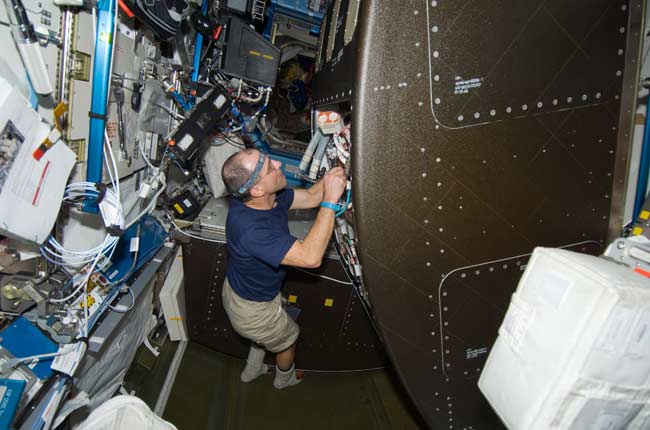Astronauts Tackle Glitches with Space Water Recycler

Thisstory was updated at 4:59 p.m. EST.
NASAastronauts and engineers are tackling an odd glitch with a new recycling systemdesigned to convert astronaut urine and sweat back into drinking water aboardthe International Space Station, flight controllers said Friday.
Efforts to runthe first batch of urine through station?s new Water Recovery System to test itsability to filterand purify water from the waste have hit repeated roadblocks over the lastfew days, station flight director Courtenay McMillan said in an afternoonupdate.
Whencommands were sent through the $250 million system?s Urine Processor Assemblyto begin filtering urine late Thursday, an alarm sounded that sent stationastronauts hunting for any signs of smoke or fire. It was a false, andunexpected, alarm that was even heard via radio by spacewalkersworking outside the station.
The urineprocesser was activated for about two hours today, but shut down unexpectedly. Theproblem could be due to a sensor glitch or the more serious malfunction of avital centrifuge motor used in one of the first steps of urine distillation,McMillan said.
?Right now,folks are still looking at the data,? McMillan said. ?They?re really stillinvestigating and determining forward steps.?
Meanwhile,engineers hope to continue efforts to test the recycling system?s ability tocollect wastewater and condensed sweat from the space station?s atmosphere andfilter it into drinking water.
Breaking space news, the latest updates on rocket launches, skywatching events and more!
The waterrecycling system is part of a bounty of new life support and living equipmentdelivered to the International Space Station this week aboardNASA?s shuttle Endeavour. A second kitchen, extra bathroom, new gymequipment, a space food refrigerator and two spare bedrooms were also hauled tothe station aboard Endeavour.
NASA flightcontrollers are weighing whether to extend Endeavour?s planned 15-day missionby one extra day to allow more time to troubleshoot the water recycling glitch.Endeavour is currently slated to leave the space station on Thanksgiving Dayand land Nov. 29.
?We are hopingthat we can try again today just to get some more time with the system beforethe end of the mission,? McMillan said.
Endeavour?sseven-astronaut crew was slated to continue moving supplies into the stationtoday. All 10 astronauts aboard both spacecraft spoke with reporters on Earththis afternoon, with the shuttle crew also scheduled to take about and hour offlater in the day.
Theastronauts also used Endeavour?s engines to boost the space station?s orbit amile higher to prepare for the planned Nov. 30 arrival of a Russian cargo ship.
Waterin, water out
The waterrecycler is a key component in plans by NASA and its station partners toboost the orbital laboratory?s population from the current three-astronautcrews to six-person expeditions capable of performing more science andmaintenance. That shift is slated for May 2009, but only if the water recyclerand other key systems are online, mission managers have said.
If it worksas designed, the system is expected to drastically reduce the amount of waterthat has to shipped to the station aboard NASA shuttles or Russian, Europeanand, eventually, Japanese spacecraft.
The systemis designed to recover about 93 percent of the initial wastewater fed into it andcould reduce the amount of water hauled aboard or generated by visitingspacecraft by 15,000 pounds (6,803 kg) per year, mission managers have said.The resulting water can then be reused for drinking, food preparation orbathing. It could also be piped through the station?s U.S. oxygen generator toproduce new air.
Waterrecovered through the system is filtered through a seven-step process and meetsmost municipal water safety standards in the U.S., said Bob Bagdigian, NASA?sproject manager for the station?s environmental control and life support systembefore launch.
Glitchesexpected
NASA?sMission Control fully expected to encounter glitches while activating the newwater recycling system. When the oxygengenerator was first delivered in 2006, it took several false starts beforethe equipment was up and running, space station flight director Ginger Kerricksaid late Thursday.
?These aregrowing pains we expected to see,? she said. ?These are very complicated piecesof equipment with a very complicated software system to control them, and thisis the first time they are all being put together in space. So it takes a whileto learn lessons from that.?
Kerricksaid there is ample time in the Endeavour crew?s schedule to troubleshoot theurine processor glitch while continuing tests on the regular wastewater side ofthe system. That part of the system can feed potable water through a localtank or feed it to a portable water dispenser on the station?s new galley.
Missionmanagers hope to return samples from each stage of the water recycling system,including the urine processor, back to Earth aboard Endeavour to begin qualitycontrol studies. Several months of additional testing and monitoring aboard thestation after Endeavour?s flight will also be required before the system willbe clear for human consumption, NASA officials have said.
?Right now,we can incorporate about a 24-hour delay in the tasks that we had planned inthe timeline and still be able - assuming everything else goes nominally - toaccomplish our sampling objectives,? Kerrick said. ?We think this is just asmall setback.?
NASA isproviding live coverage of Endeavour's STS-126 mission on NASA TV. Click here for SPACE.com'smission coverage and NASA TV feed.
- New Video - Drinking Water From Space Urine
- New Images - Stunning Views Endeavour's STS-126 Night Launch
- Images: The First 5 Years of Space Station Assembly

Tariq is the award-winning Editor-in-Chief of Space.com and joined the team in 2001. He covers human spaceflight, as well as skywatching and entertainment. He became Space.com's Editor-in-Chief in 2019. Before joining Space.com, Tariq was a staff reporter for The Los Angeles Times covering education and city beats in La Habra, Fullerton and Huntington Beach. He's a recipient of the 2022 Harry Kolcum Award for excellence in space reporting and the 2025 Space Pioneer Award from the National Space Society. He is an Eagle Scout and Space Camp alum with journalism degrees from the USC and NYU. You can find Tariq at Space.com and as the co-host to the This Week In Space podcast on the TWiT network. To see his latest project, you can follow Tariq on Twitter @tariqjmalik.
